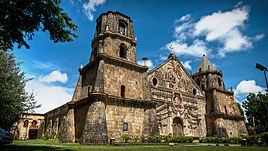This article needs to be updated. The reason given is: Negros Island Region has been revived by Pres. Ferdinand Marcos Jr. via Republic Act No. 12000 on June 13, 2024. (June 2024) |
Western Visayas (Hiligaynon: Kabisay-an Nakatundan; Tagalog: Kanlurang Kabisayaan or Kanlurang Visayas) is an administrative region in the Philippines, numerically designated as Region VI. It consists of five provinces: Aklan, Antique, Capiz, Guimaras, and Iloilo. The region also includes one highly urbanized city, Iloilo City, which is the largest city and serves as the regional center.[3]
Western Visayas Kabisay-an Nakatundan Kanlurang Kabisayaan | |
|---|---|
 Location in the Philippines | |
| Coordinates: 11°08′N 122°32′E / 11.13°N 122.53°E | |
| Country | |
| Island group | Visayas |
| Regional center and largest city | Iloilo City |
| Area | |
| • Total | 12,750.63 km2 (4,923.05 sq mi) |
| Highest elevation | 2,117 m (6,946 ft) |
| Population (2020 census)[1] | |
| • Total | 4,730,771 |
| • Density | 370/km2 (960/sq mi) |
| Time zone | UTC+8 (PST) |
| ISO 3166 code | PH-06 |
| Provinces | |
| Independent cities | |
| Component cities | |
| Municipalities | 98 |
| Barangays | 3,209 |
| Cong. districts | 10 |
| Languages | |
| GDP (2023) | ₱620.79 billion $10.55 billion[2] |
| HDI | |
| HDI rank | 5th in the Philippines (2019) |
The Hiligaynon language, native to Iloilo City, is the region's lingua franca. The region is also dominated by the native speakers of three Visayan languages: Kinaray-a, Aklanon and Capiznon. The land area of the region is 12,750.63 km2 (4,923.05 sq mi), and with a population of 4,730,771 inhabitants.
Etymology
editThe region's current name is in reference to its geographic position in the greater Visayas area.
History
editRegions first came into existence on September 24, 1972, when the provinces of the Philippines were organized into 11 regions by Presidential Decree No. 1 as part of the Integrated Reorganization Plan by President Ferdinand Marcos Sr. The provinces of Aklan, Antique, Capiz, Iloilo (including its then-subprovince of Guimaras), and Negros Occidental were grouped together to form the Western Visayas region.
The province of Palawan was transferred to Region VI (Western Visayas) on May 23, 2005, by Executive Order 429.[4] The Department of the Interior and Local Government announced in June 2005 that the transfer had been completed.[5]However, Palaweños criticized the move, citing a lack of consultation, with most residents in Puerto Princesa City and all municipalities but one preferring to stay with Region IV-B. Consequently, Administrative Order No. 129 was issued on August 19, 2005, to address this backlash. This Order directed the abeyance of Executive Order 429 pending the approval of an implementation plan for the orderly transfer of Palawan from Region IV-B to Region VI.[6]Hence, Palawan is currently still part of Region IV-B.
By virtue of Executive Order No. 183 issued on May 29, 2015, by President Benigno Aquino III, the province of Negros Occidental and its capital, Bacolod, were both removed from Western Visayas in order to form the Negros Island Region along with Negros Oriental.[7] But later regained Negros Occidental and its capital, Bacolod City back into Western Visayas on August 9, 2017, when President Rodrigo Duterte dissolved the Negros Island Region, revoking Executive Order No. 183, s. 2015 through the signage of Executive Order No. 38, citing the reason of the lack of funds to fully establish the NIR according to Benjamin Diokno, the Secretary of Budget and Management.[8]
On June 13, 2024, the region again lost Negros Occidental and Bacolod when the Negros Island Region was reestablished under Republic Act No. 12000 signed by President Ferdinand Marcos Jr.[9]
Geography
editWestern Visayas consists of the major island of Panay and the smaller Guimaras, as well as several outlying islands. Its land area is 12,750.63 km2 (4,923.05 sq mi), 4.25% of the country's total land area.
The region is bordered to the north by the Sibuyan Sea, northeast by the Visayan Sea, southeast by the island of Negros, south by the Iloilo Strait and Panay Gulf, and west by the Sulu Sea.
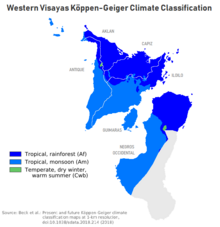
Administrative divisions
editProvinces
editWestern Visayas consists of 5 provinces, 1 highly urbanized city, 2 component cities, 98 municipalities and 3,209 barangays.
| Province or HUC | Capital | Population (2020)[1] | Area[10] | Density | Cities | Muni. | Barangay | |||||
|---|---|---|---|---|---|---|---|---|---|---|---|---|
| km2 | sq mi | /km2 | /sq mi | |||||||||
| Aklan | Kalibo | 7.7% | 615,475 | 1,760.30 | 679.66 | 350 | 910 | 0 | 17 | 327 | ||
| Antique | San Jose de Buenavista | 7.7% | 612,974 | 2,730.67 | 1,054.32 | 220 | 570 | 0 | 18 | 590 | ||
| Capiz | Roxas | 10.1% | 804,952 | 2,594.64 | 1,001.80 | 310 | 800 | 1 | 16 | 473 | ||
| Guimaras | Jordan | 2.4% | 187,842 | 611.87 | 236.24 | 310 | 800 | 0 | 5 | 98 | ||
| Iloilo | Iloilo City | 25.8% | 2,051,899 | 4,997.64 | 1,929.60 | 410 | 1,100 | 1 | 42 | 1,721 | ||
| Iloilo City | † | — | 5.8% | 457,626 | 78.34 | 30.25 | 5,800 | 15,000 | — | — | 180 | |
| Total | 4,730,771 | 12,750.63 | 4,923.05 | 370 | 960 | 2 | 98 | 3,209 | ||||
| ||||||||||||
Governors and vice governors
edit| Province | Image | Governor | Political Party | Vice Governor | |
|---|---|---|---|---|---|
 | Jose Enrique Miraflores | PDP–Laban | Reynaldo Quimpo | ||
 | Rhodora Cadiao | NUP | Edgar Denosta | ||
 | Fredenil Castro | Lakas | James Magbanua | ||
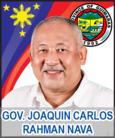 | Joaquin Carlos Rahman Nava | NUP | John Edward Gando | ||
 | Arthur Defensor Jr. | NUP | Christine Garin | ||
Cities
edit- † Regional center
| City | Population (2020)[1] | Area | Density | City class | Income class | Province | ||
|---|---|---|---|---|---|---|---|---|
| km2 | sq mi | /km2 | /sq mi | |||||
| † Iloilo City | 457,626 | 78.34 | 30.25 | 5,800 | 15,000 | Highly urbanized | 1st | Iloilo |
| Passi | 88,873 | 251.39 | 97.06 | 350 | 910 | Component | 4th | Iloilo |
| Roxas | 179,292 | 95.07 | 36.71 | 1,900 | 4,900 | Component | 1st | Capiz |
Demographics
edit| Year | Pop. | ±% p.a. |
|---|---|---|
| 1903 | 1,083,474 | — |
| 1918 | 1,347,249 | +1.46% |
| 1939 | 2,173,579 | +2.30% |
| 1948 | 2,530,517 | +1.70% |
| 1960 | 3,078,305 | +1.65% |
| 1970 | 3,618,326 | +1.63% |
| 1975 | 4,146,390 | +2.77% |
| 1980 | 4,525,615 | +1.77% |
| 1990 | 5,393,333 | +1.77% |
| 1995 | 5,776,938 | +1.30% |
| 2000 | 6,211,038 | +1.57% |
| 2007 | 6,843,643 | +1.35% |
| 2010 | 7,102,438 | +1.36% |
| 2015 | 7,536,383 | +1.14% |
| 2020 | 7,954,723 | +1.07% |
| Data in 2015 and 2020 includes Negros Occidental and Bacolod. Source: Philippine Statistics Authority[11][12] | ||
According to the 2020 census, it has a population of 4,730,771. Before Negros Occidental and Bacolod separated from the region in 2024, it was 7,954,723.
Languages
edit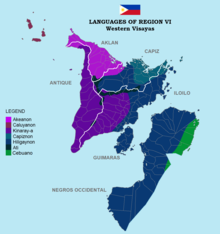
The native languages of Western Visayas are:
- Aklanon/Akeanon, spoken in Aklan and northwestern Capiz.
- Capiznon, spoken in Capiz, northeastern Iloilo, and eastern Aklan.
- Hiligaynon, spoken in Iloilo, Guimaras, Capiz, Antique, and Aklan. It is the regional lingua franca.
- Kinaray-a, spoken in Antique, southwestern half of Iloilo, Guimaras, western Capiz, and southwestern Aklan.
- Malaynon, spoken in northwestern Aklan including Boracay Island.
- Caluyanon, spoken in the Semirara Islands (Semirara, Caluya, and Sibay Islands).
Economy
edit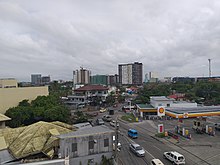
Poverty incidence of Western Visayas
10 20 30 40 2006 29.08 2009 30.80 2012 29.14 2015 24.60 2018 16.32 2021 13.80 Source: Philippine Statistics Authority[13][14][15][16][17][18][19][20] |
Western Visayas is the sixth largest economy in the Philippines.[21] Iloilo City serves as the region's economic hub. Other major trading and commercial centers in the region include Roxas City for Capiz and entire Northern Panay. Provincial capitals such as Kalibo in Aklan, San Jose in Antique, and Jordan in Guimaras serve as the commercial centers for their respective provinces. Metro Iloilo, composed of Iloilo City and the municipalities of Oton, San Miguel, Pavia, Leganes, Santa Barbara, and Cabatuan, is the center for trading, commercial, financial, and industrial activities in the region.
Tourism
edit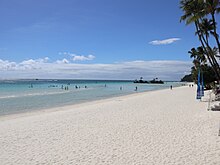
The region is known for its rich cultural heritage and natural beauty, features several key tourism highlights. Boracay Island, located in Malay, Aklan, is world-famous for its pristine white sand beaches, crystal-clear waters, and vibrant nightlife. Miag-ao Church in Miag-ao, Iloilo, a UNESCO World Heritage Site, showcases unique Baroque-Romanesque architecture and detailed designs. Iloilo City, a UNESCO Creative City of Gastronomy, is also known for its colonial-era heritage houses, churches, and buildings. The Gigantes Islands in Carles, Iloilo, are known for their white sand beaches, sandbars, limestone cliffs, and clear blue waters. Panay Church in Panay, Capiz hosts the biggest church bell in Asia. Mount Madja-as in Antique is the highest mountain in the region. Guimaras mangoes from Guimaras are known as some of the sweetest in the world. The region is also home to popular festivals such as the Dinagyang of Iloilo City and the Ati-Atihan of Kalibo, Aklan.
Transportation
editPorts
edit
The Port of Iloilo is the primary seaport serving the region. Other seaports include Dumangas Port in Dumangas, Iloilo, serves ro-ro and fastcraft to Negros Island and vice versa; Jordan Port in Guimaras, serves ferries from Iloilo City and vice versa; Culasi Port in Roxas, Capiz, serves ferry routes to Batangas and Caticlan and vice versa; Caticlan Port in Malay, Aklan, serves ferries to Boracay Island and vice versa; and the Port of San Jose de Buenavista in Antique, which serves ferries to Palawan and Iloilo City and vice versa.
Airports
editWestern Visayas is served by two international airports and three domestic airports. Iloilo International Airport, located in Cabatuan, Iloilo, serves the general area of Metro Iloilo–Guimaras as well as the entire province of Iloilo, and a gateway into the region. Kalibo International Airport serves the general area of Aklan and is one of the two airports serving Boracay, the other being the domestic Godofredo P. Ramos Airport in Caticlan, Malay, Aklan. The other domestic airports are Roxas Airport, serving the general area of area of Roxas City and the province of Capiz, and Evelio B. Javier Airport, serving the general area of the province of Antique.
The other airports and airstrips in the region include Semirara Airport on Semirara Island in Caluya, Antique; Sicogon Airport on Sicogon Island in Carles, Iloilo; and Guimaras Airstrip.
Rail
editProposals to re-connect again Iloilo-Roxas, Iloilo-Kalibo, Iloilo-Malay (Aklan) and Iloilo-San Jose (Antique) from the Iloilo City via rail was included in the revival of the currently defunct Panay Railways network which has a station in Santa Barbara town proper.[22]
References
editExternal links
edit Media related to Western Visayas at Wikimedia Commons
Media related to Western Visayas at Wikimedia Commons Western Visayas travel guide from Wikivoyage
Western Visayas travel guide from Wikivoyage Geographic data related to Western Visayas at OpenStreetMap
Geographic data related to Western Visayas at OpenStreetMap
